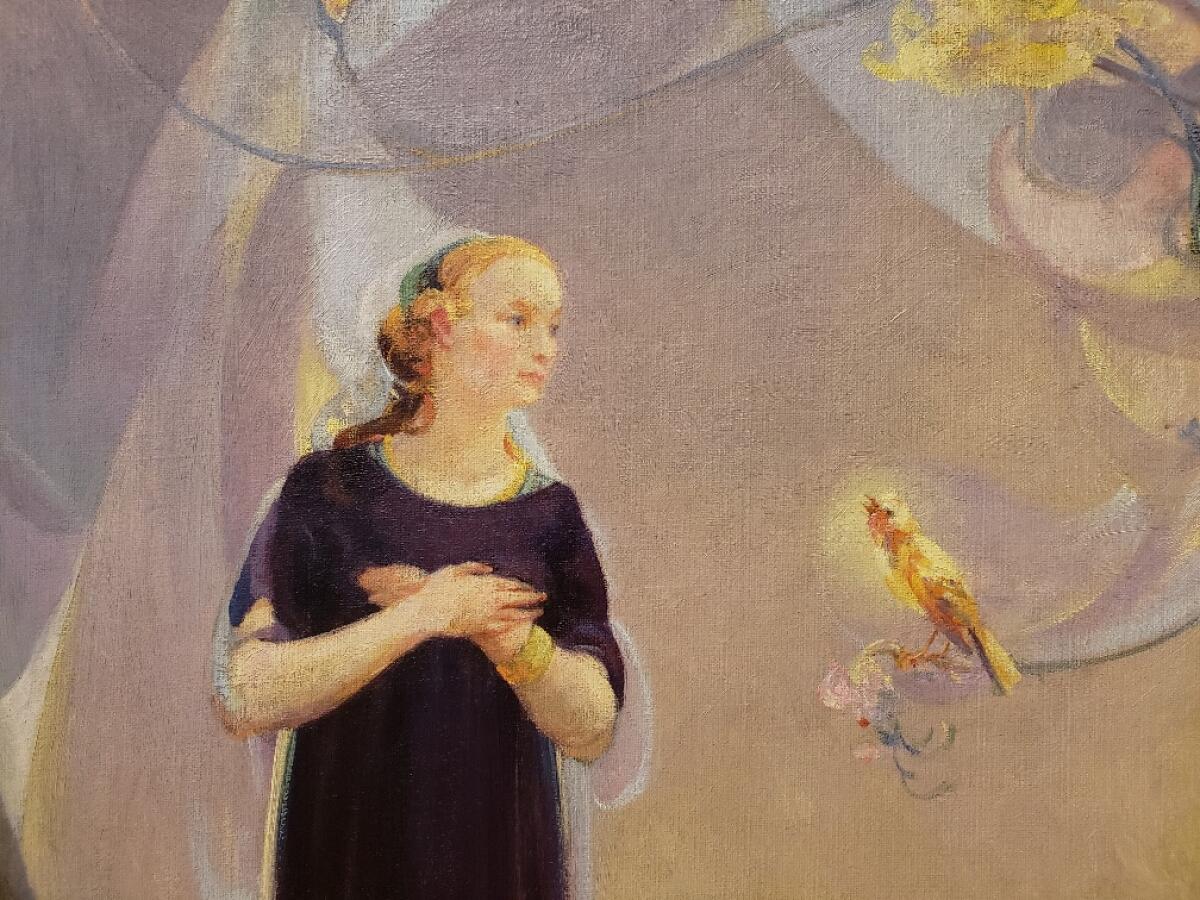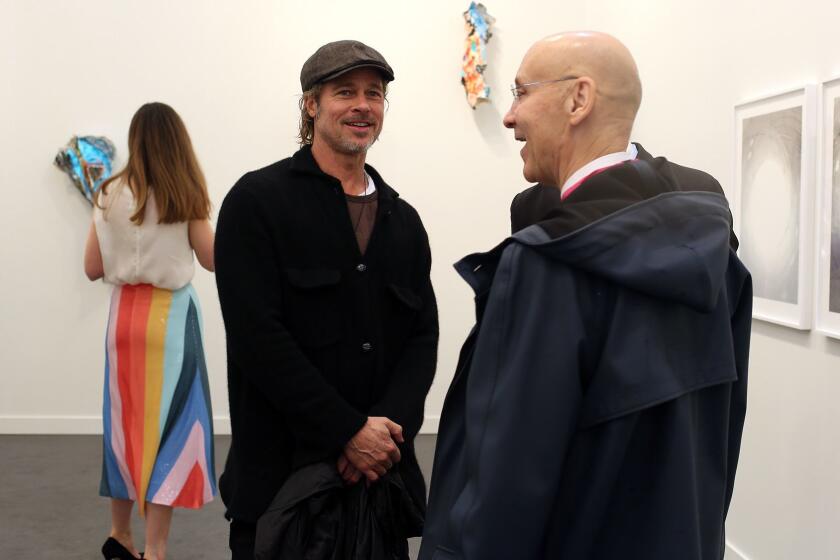Review: The glorious mysteries of Agnes Pelton’s desert paintings, on view in Palm Springs
Palm Springs — For Agnes Pelton, painting was a profound means for contemplation. Hers and ours.
Take “Messengers,” which centers on a luminous, vase-like translucent vessel floating in a dusky sky above a stylized, silhouetted mountain range. A light blue orb rises behind the mountains and before a pale wash of color, which steadily climbs to become a deep purple plane. Eight soft violet lights glow along the upper edge above six bright, golden palm fronds draped across the vessel’s top.
The painting is among the finest in “Agnes Pelton: Desert Transcendentalist,” a lovely exhibition at the Palm Springs Art Museum. It dates from 1932, amid the most productive period of the artist’s more than four-decade career.
The mountains in the picture were inspired by the San Jacinto and Santa Rosa ranges at the edge of the Coachella Valley, where the artist lived. Likewise, the palm fronds derive from a local source — traditional shelters built by the region’s indigenous Cahuilla Indians.
In Pelton’s mythic compositions, however, rarely is anything only one thing. The shining leaves also suggest the classical Greek wreath with which a triumphant victor would be crowned, as well as a Haku lei common to the Hawai’ian rituals she observed during an earlier, two-year sojourn to those Pacific islands. The softly glowing vessel gets subtly nudged into the suggestion of an abstract head — a spirit-being embedded within and presiding over nature’s wonders.
Putting delicate brush to canvas to make the abstract picture was Pelton’s avenue for slow, considered thought and deep reflection. Painting in thin glazes and slight, stippled marks — a protracted, time-consuming process — she almost never let the action of her hand intrude on the theatricalized scene. In her mature work, Pelton turned the anonymous, machine-stylization of Art Deco to uncannily naturalistic ends.
Close looking is the contemplative path for a viewer. In “Messengers,” the radiant, jewel-toned apparition of a humanized vessel overflowing with light amid celestial phenomena suggests transformational states of consciousness, all in the modest scale of an easel painting that pulls you in for intimate perusal. Just 28 inches by 20 inches, it’s an icon for private devotion.
Pelton’s retrospective is her second at the Palm Springs Art Museum. (The first was in 1995.) Intended to run from late last summer through the fall, the last stop in a well-received four-city national tour, the show was postponed by the COVID-19 pandemic’s closure of the museum. There was something unhappily poetic about knowing that her visionary paintings were locked up tight inside the shuttered museum, unavailable to be seen.
Pelton lived and worked, mostly in obscurity, in a little house in Cathedral City, seven short miles from the museum, from 1932 until her death at 80 in 1961. She showed in many exhibitions, including the pivotal Armory Show, which introduced European avant-garde art to American audiences in 1913; but support for abstract painting was always tiny. Throughout her life, her work received scant notice beyond a small circle of like-minded admirers.
The show, organized by the Phoenix Art Museum, is billed in the catalog as a rediscovery of the artist, but it isn’t really. That happened a quarter-century ago. The first Pelton survey, organized for the Palm Springs museum by the late curator Michael Zakian, who contributed an essay to the current catalog, was a revelation, reintroducing a mostly forgotten American Modernist.
Pelton’s place was further amplified in 2009, when her work stood out in “Illumination,” an exhibition at the Newport Harbor Art Museum (now Orange County Museum of Art) of abstract paintings by four women who worked in the deserts of the American Southwest. (Georgia O’Keeffe, Agnes Martin and Florence Miller Pierce were the others.) The current show secures her significant place among early American Modern artists.
Pelton was born in Stuttgart, Germany, to wealthy (if troubled) American parents in 1881. Her mother had left the United States for Europe to escape the explosive scandal around Pelton’s grandfather, Theodore Tilton, who had sued the famous charismatic preacher Henry Ward Beecher for an adulterous affair with Tilton’s wife. (The trial ended with a hung jury.) In Germany, Pelton’s mother married a rich American expat, who didn’t fare much better, dying from a morphine overdose when Agnes was 9.
Back in New York, Pelton began to embrace Symbolist art. She studied Theosophy and other occult systems, especially the writings of Helena Blavatsky, and enrolled at Pratt Institute to study art with Arthur Wesley Dow. Blavatsky’s esoteric texts worked well with Dow’s revolutionary aesthetic philosophy (which also influenced O’Keeffe). He taught that a painting’s formal elements of line, composition and color should fuse with exposure of the artist’s imaginative inner life.
“Concerning the Spiritual in Art,” the widely read 1910 manifesto by abstract painting pioneer Wassily Kandinsky, cemented her Symbolist direction.

The exhibition opens with a decorative 1917 painting — at just over 5 feet by 4 feet, by far the largest Pelton ever made — in which a solemn woman in a long, columnar gray dress, hands crossed piously over her breast, listens attentively to the song of a golden bird perched on a sinuous floral vine. The purple and yellow palette that dominates the swirling landscape is a traditional color-symbol for spirituality and wisdom.
Faceless, bodily presences in landscape abstractions like the one in “Messengers” turn up often in her work, even where least expected.
There’s one in “Orbits,” where seven shining stars dart about along dotted oval traceries before a dark, swollen vessel shape that hovers in the sky. A pair of violet ovals at the top meet a white triangle whose scalloped bottom edge is like a lace collar. Pointed at the top, the shape doubles as the snow-capped peak of Mt. San Jacinto above Palm Springs.
Frieze Los Angeles scraps plans for a July fair and instead focuses on next year, picking dates — and a new Beverly Hills location — for February.
“Even Song” is another luminous vessel that morphs evocatively into a head. Miasmic swirls of ethereal color suggest emerging figures in “Being” and “The Fountains.”
Elsewhere, a swell of organic shapes above a flattened brown expanse no doubt owes its origins to distended cloud formations blossoming over the desert. Titled “Sea Change,” the image puts one in mind of primitive life forms crawling out of an ocean — appropriate for a desert that began existence as an ancient seabed.
One drawback of the show is that 10 pictures were trimmed from the original presentation. That’s a lot. With just 35 paintings now, it feels small for a retrospective. (About 100 abstract works are known.) Maybe the pandemic extension is to blame.
Several of Pelton’s finest, most daring abstractions were in neither version, however, blunting the impact. Among the missing is “The Voice” (an anemone-like explosion of tendrils), “White Fire” (a rich plane of sapphire color supporting a braided column of white light embedded with eye-like stars) and “Wells of Jade” (imagine pearls in formation inside an oyster shell around an unseen irritant). All date from 1931, smack in the middle of the transformative moment of Pelton’s own art.
She had spent much of 1928 and 1929 in Pasadena, where the experience of limpid California light had a profound impact on her work. In 1932, at the age of 50, she left New York for good and moved to the mouth of the desert’s sparsely populated Cathedral Canyon. The economy had collapsed; the long haul of the Great Depression was looming.
Pelton, setting herself against the grinding difficulties of the day, began to paint focused visions of spiritual hope rooted in ancient mysteries.
The Hammer and Huntington biennial, ‘Mesopotamia’ at the Getty Villa, Wayne Thiebaud, Yoshitomo Nara, butterflies and the Disney archives: exhibitions at SoCal’s reopened museums.
A welcome feature of the Palm Springs show is the addition of a revealing exhibition, organized by curator Christine Giles, focused on Pelton’s realist landscape paintings. Many were made to appeal to a tourist trade uninterested in abstract art, so this body of work is often overlooked. It shouldn’t be. Pelton brought her gifts, manual and intellectual, to everything she painted.
Among the 16 landscape paintings and five drawings are wonderful images of smoke trees and date palms. Somehow she painted the atmosphere within which desert plant life exists, rather than just the plants themselves. The best brim with the same irrepressible, enigmatic life as her riskier abstractions.
'Agnes Pelton: Desert Transcendentalist'
Where: Palm Springs Art Museum, 101 Museum Drive.
When: Thursdays-Sundays through Sept. 6; reservations required, COVID-19 protocols in place
Admission: $6-$14; children younger than 18 are free
Info: (760) 322-4800, www.psmuseum.org
More to Read
The biggest entertainment stories
Get our big stories about Hollywood, film, television, music, arts, culture and more right in your inbox as soon as they publish.
You may occasionally receive promotional content from the Los Angeles Times.












